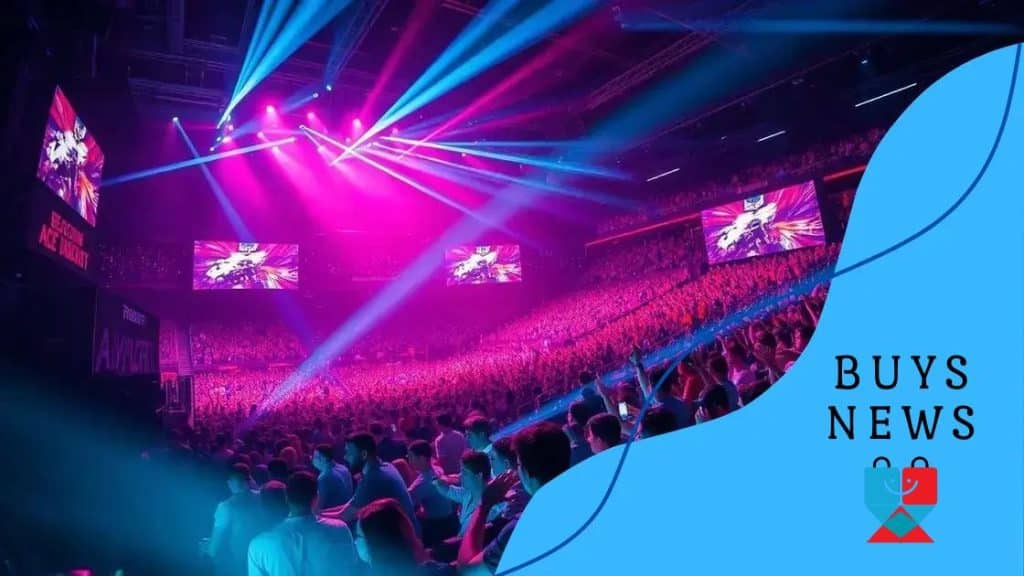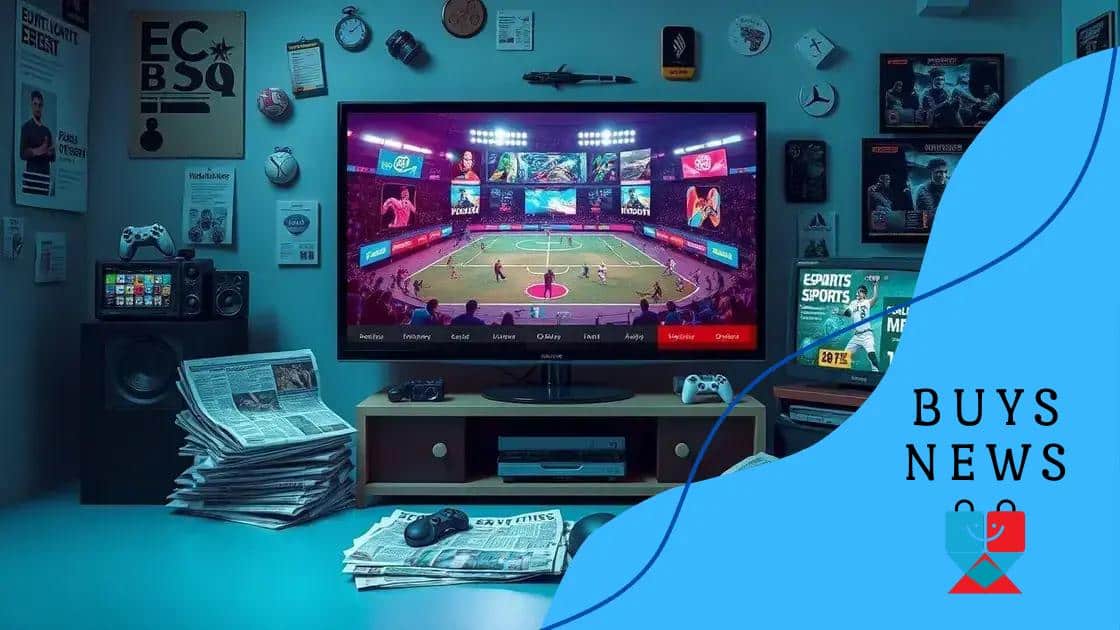How e-sports are influencing mainstream media content

How e-sports are influencing mainstream media content involves immersive viewer engagement through technology, increased sponsorships, and collaborations between e-sports organizations and traditional media, reshaping the entertainment landscape.
How e-sports are influencing mainstream media content is a fascinating topic that affects both audiences and creators. Have you noticed how gaming competitions are now headlining major networks? Let’s dive into this exciting transformation.
The rise of e-sports in popular culture
The rise of e-sports in popular culture has been nothing short of remarkable. In recent years, this phenomenon has captivated millions of fans around the world. E-sports aren’t just games anymore; they’re events that draw massive crowds both online and offline.
One driving force behind the growth is the increasing accessibility of gaming technology. With the rise of streaming platforms, anyone can watch top players compete in real-time. This has created a vibrant community of viewers who are eager to engage with their favorite gamers.
Major Events and Their Impact
High-profile tournaments, such as the League of Legends World Championship and The International for Dota 2, have become monumental events in the gaming calendar. These tournaments attract millions of viewers and hefty prize pools. They’re comparable to traditional sports events in terms of excitement and fan engagement.
- Growing sponsorship deals with large brands.
- Increased media coverage across multiple platforms.
- A surge in local e-sports leagues and competitions.
As e-sports events gain in viewership, they also attract diverse audiences. People of all ages join in, making it a unique blend of entertainment for everyone. From the casual gamer to the hardcore fan, the appeal of e-sports is universal.
Cultural Integration
Another significant aspect of this rise is how it integrates with various cultures. Many e-sports titles draw inspiration from stories and characters familiar to fans of movies and comics. This cross-pollination enriches both the gaming world and traditional media.
Furthermore, as mainstream media takes notice, we see popular media outlets coverage expand. Major networks now broadcast e-sports events, leading to more exposure for this evolving field. This visibility solidifies e-sports as a serious cultural force.
In conclusion, the rise of e-sports in popular culture represents a dynamic shift in entertainment. With its deepening roots, we can expect this genre to thrive, continually reshaping how we view competition and community.
How e-sports are changing viewer engagement
How e-sports are changing viewer engagement is a game changer in today’s entertainment industry. With interactive features and community involvement, e-sports transform spectators into participants.
One way this transformation happens is through live streaming platforms. Viewers don’t just watch; they can interact with streamers via chat, making them feel part of the action. This direct interaction increases engagement levels significantly.
The Role of Social Media
Social media also plays a crucial role in connecting fans with their favorite players. Platforms like Twitter, Instagram, and TikTok create a space for players and fans to share highlights, strategies, and personal glimpses into the gaming life.
- Real-time updates on games and tournaments.
- Engaging behind-the-scenes content from players.
- Opportunities for fans to ask questions and give feedback.
As more people join these online communities, the feel of camaraderie deepens. Fans discuss games, celebrate victories, and even share losses together, strengthening their connection to both the games and the players.
Innovative Formats
Additionally, unique viewing experiences such as virtual reality (VR) are paving the way for the future of e-sports engagement. Viewers can feel as though they are in the arena, experiencing the thrill of high-stakes competition firsthand.
Furthermore, e-sports orgs are increasingly developing interactive formats that allow viewers to influence outcomes, such as prediction games. These features not only attract more viewers but also keep them coming back for more, enhancing their connection to the events.
As we can see, the landscape of viewer engagement is evolving due to e-sports. This shift reflects a broader trend towards immersive and multi-dimensional experiences in entertainment.
The impact of e-sports on traditional media

The impact of e-sports on traditional media is profound and continues to shape how audiences consume content. As e-sports gain popularity, they attract attention from conventional media sources, which are adapting to this new trend.
Television networks and streaming services are now broadcasting e-sports competitions, drawing in large audiences. This shift highlights the growing acceptance of gaming as a legitimate form of entertainment.
Merger of Two Worlds
As e-sports enter mainstream media, they create unique opportunities for cross-promotion. Traditional sports channels often feature e-sports segments, which helps broaden their audience base. Major events, such as e-sports championships, can now be found on prominent sports networks.
- Collaborations between traditional sports teams and e-sports organizations.
- Increased sponsorship deals linking e-sports with major brands.
- Documentaries and shows focusing on e-sports figures and events.
This merger fosters an environment where both industries can prosper, reaching new viewers who might not typically engage with either format independently.
Changing Content Creation
Additionally, traditional media companies are learning from e-sports. They are now embracing more interactive content, allowing viewers to participate in polls or live discussions during broadcasts. This enhances viewer engagement in ways that were not previously common in television.
Through social media, fans can now share their thoughts and reactions in real-time, creating a lively conversation around the events. This dynamic interaction is enhancing the viewing experience significantly, making it more lively and community-driven.
Ultimately, e-sports are encouraging traditional media to innovate, fueling a fresh wave of content that resonates with younger audiences.
The role of sponsorships in e-sports media
The role of sponsorships in e-sports media has become increasingly vital as the industry expands. Companies are recognizing the potential to reach new audiences through e-sports. This financial support not only helps players and teams but enhances the production quality of events.
Sponsorships provide funding for tournaments and help in marketing efforts. Well-known brands are keen to align themselves with popular games and players. This relationship creates a win-win situation, benefiting both the sponsors and the e-sports community.
Exposure for Brands
Brands sponsoring e-sports events gain exposure to a younger demographic that is highly engaged. Gamers often view these brands as part of their community, leading to brand loyalty. Through live broadcasts and advertisements, sponsors reach millions of viewers.
- Increased visibility on streaming platforms.
- Targeted campaigns during major tournaments.
- Opportunities for product placements within games.
As e-sports events grow in popularity, sponsors also collaborate with popular streamers. This partnership helps in creating authentic content that resonates with fans. These influencers often showcase products in a way that feels natural, further increasing their effectiveness.
Transforming Advertising Strategies
E-sports sponsorships are changing how brands approach advertising. Traditional commercials might not grab the attention of gamers, but interactive campaigns and live events do. Many sponsors now adopt experiential marketing strategies to engage fans directly.
For example, brands often host gaming lounges at live events, inviting fans to try their products while interacting with pros. This interaction builds community and strengthens the relationship between fans and brands. Overall, sponsorships are crucial in propelling the e-sports industry forward, creating a more dynamic media landscape.
Future trends in e-sports and media collaboration
Future trends in e-sports and media collaboration showcase exciting possibilities for both industries. As technology continues to evolve, so do the ways e-sports and media interact. This partnership is likely to become even more integrated, creating fresh experiences for fans.
Innovations like augmented reality (AR) and virtual reality (VR) are paving the way for immersive viewing experiences. Imagine watching a match from the front row of a virtual stadium, feeling as if you are right there with the players. Such technologies open new avenues for how audiences engage with live events.
Personalized Content Delivery
Another emerging trend is the emphasis on personalized content delivery. Streaming platforms are already using algorithms to suggest content based on viewing habits. This enhances viewer engagement by providing tailored experiences that meet individual preferences.
- Rise of interactive watch parties with friend features.
- Customizable viewing options, like selecting camera angles.
- Integration of live stats and analytics during streams.
As e-sports continue to grow, collaborations with media platforms will likely focus on creating these personalized experiences. Fans want to feel directly involved, and this approach allows them to do just that.
Cross-Promotion with Traditional Media
The future will also likely see more cross-promotion between e-sports and traditional media. Sporting networks could increase coverage of e-sports leagues, while entertainment channels might feature gaming-themed shows, bringing wider recognition to the genre.
These crossovers will help attract diverse audiences and create shared experiences. As traditional media embraces e-sports, it can revitalize its content and reach new demographics.
Ultimately, the collaboration between young, innovative e-sports and established media will build a future rich with opportunities and engagement for viewers everywhere.
FAQ – Frequently Asked Questions about E-Sports and Media Collaboration
How are e-sports changing viewer engagement?
E-sports are enhancing viewer engagement through interactive platforms, allowing fans to participate in real-time discussions and have personalized viewing experiences.
What role do sponsors play in e-sports?
Sponsors provide essential funding for events and enhance marketing efforts, creating mutual benefits for both e-sports players and the brands.
What technologies are influencing the future of e-sports?
Technologies like augmented reality (AR) and virtual reality (VR) are creating immersive experiences, making online competitions more engaging for fans.
How is traditional media adapting to e-sports?
Traditional media is increasing coverage of e-sports events, collaborating with e-sports organizations to attract broader audiences and create new content formats.





